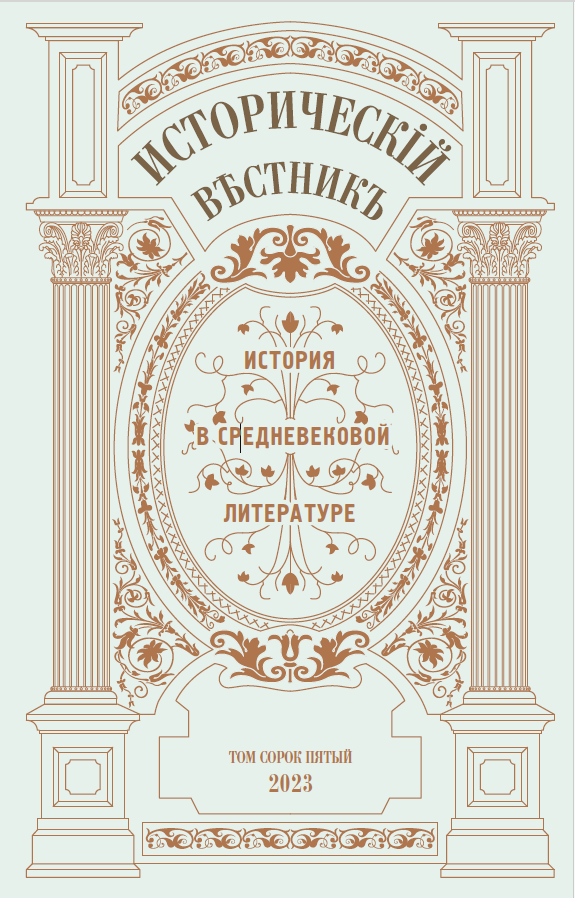HISTORY DEPICTED IN MEDIEVAL SOURCES
VOL. 45 [192]
september 2023
EDITORIAL
The central theme of this issue pf the Historical Reporter is the portrayal of historical events in Medieval Russian literature.
The studies by Elena L. Konyavskaya and Alexandra V. Dukhanina are dedicated to the Lives of Russian Saints. Elena L. Konyavskaya explores the depiction of historical reality in early hagiographic works: the Life of Theodosius of the Caves (11th century) and the Life of Abraham of Smolensk (13th century). Alexandra V. Dukhanina’s work, in turn, investigates the historical elements in the abridged editions of the Life of Stephan of Perm (15th century).
Another two papers delve into the Mongol invasion of Russia in the 13th century. Andrey A. Astaykin provides a detailed analysis of the chronicle known as the Tales of the Battle of Kalka (that battle marks its 800th anniversary in 2023). His article traces the evolution of the Tales from early accounts (the First Novgorod Chronicle, the Laurentian Codex, and the Hypatian Codex) to later records, up to the end of the 17th century. Vladimir N. Rudakov discusses the accounts of Batu Khan’s invasion of North-Eastern Russia in 1237–1238. He focuses his attention on two large-scale battles, near Kolomna and on the River Sit’, tracking how the perception and literary interpretation of these events evolved from the 13th to the 17th century.
Yury V. Seleznev’s work looks at one of the earliest Russian chronicles, the Laurentian Codex, which ends on the year 1304 — specifically at how it documents the relationship between Rus’ and the Ulus of Jochi (The Golden Horde). A comprehensive analysis reveals unique aspects of internal political development within the Horde during the latter half of the 13th century.
Anton A. Gorsky’s article questions when the historical treatises of Ancient Rus’ first started featuring elements of clear literary fiction. After examining three works from the same historical period, the early 16th century — The Tale of Mamai’s Battle, The Tale of the Destruction of Ryazan by Batu Khan, and the Nikon Chronicle — the author concludes that they all contain entirely fictional episodes and plotlines, suggesting that artistic embellishments became prevalent in historical narratives specifically in the 16th century.
The Sources section, as per editorial guidelines, may not necessarily align with the theme of the issue. It will feature a contribution by Andrey V. Ganin, with the very first look at the investigation case files on a notable figure of the White Movement, Colonel Leonid V. Kostandi.
Alexey E. Titkov, Editor-in-Chief of the Historical Reporter
CONTENTS
Elena L. Konyavskaya. Historical Reality Depicted in Early Russian Hagiography
Andrey A. Astaykin. The Tale of the Battle of Kalka in Russian Chronicles of the 13th–18th Centuries
Vladimir N. Rudakov. The Memory of the Two Battles of the Batu’s Invasion Epoch
Yury V. Seleznev. Laurentian Codex as the Source About the Ulus of Jochi (The Golden Horde)
Alexandra V. Dukhanina. The Notion of History: Evolution of Historical Components within Short Editions of the Life of Stephan of Perm
Anton A. Gorsky. The Tale of Mamai’s Battle, The Tale of the Destruction of Ryazan by Batu Khan, and the Nikon Chronicle: the Beginning of the Russian Historical Fiction
HISTORICAL THOUGHT
Marianna Yu. Andreycheva. «The shelter of death…» Review of a Joint Monograph by V.A. Voropaev, I.V. Dergacheva, E.L. Konyavskaya, V.V. Mil’kov «Thanatological Theme in Russian Literature of the 11th–21st centuries»
SOURCES
Andrey V. Ganin. «I don’t fit abroad…» Investigatory Records on Colonel L.V. Kostandi (1920–1921)



